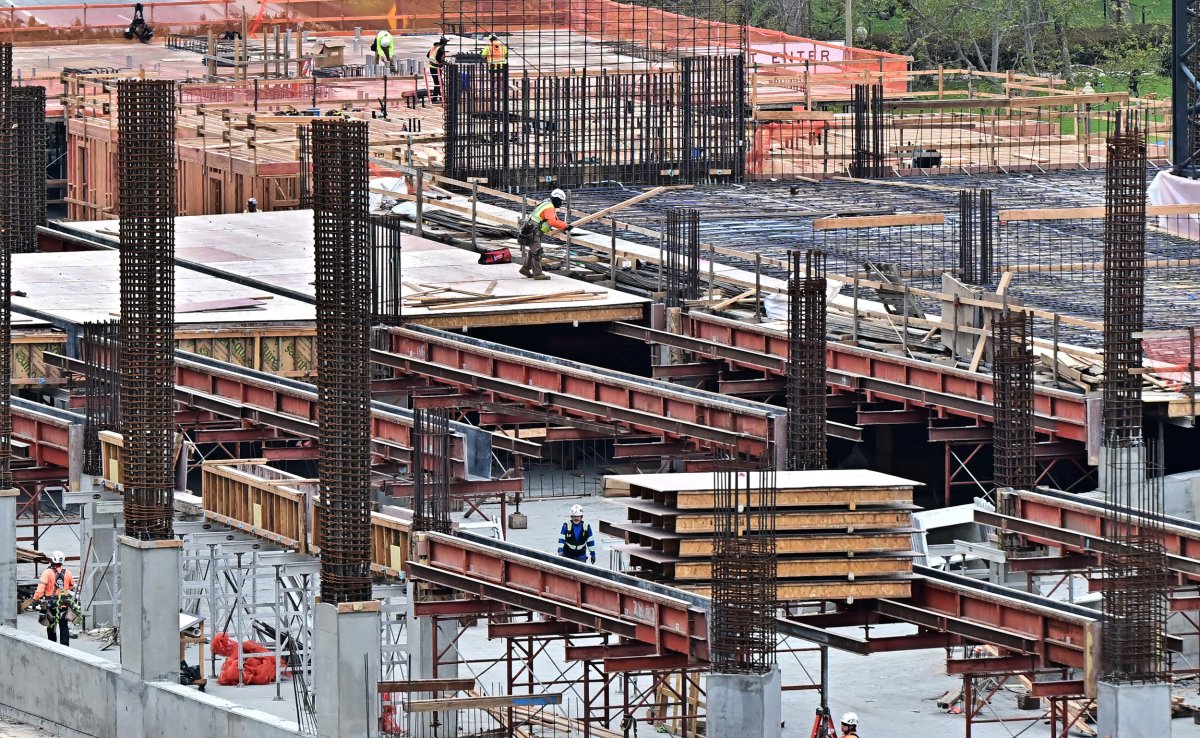-
Dodgers vs. Cardinals Highlights | MLB on FOX - 5 mins ago
-
Eagles DC Delivers Confident Message After Critical Losses - 26 mins ago
-
Gaza families mark Eid al-Adha amid destruction and loss - 44 mins ago
-
A. P. Kid wins 2025 Pennine Ridge Stakes - 48 mins ago
-
Chaos erupts at Paramount Home Depot as protesters confront ICE - about 1 hour ago
-
Riley Gaines and Simone Biles Beef Online Amid Trans Athlete Debate - about 1 hour ago
-
Rod Stewart, 80, cancels 6 concerts as he battles the flu - about 1 hour ago
-
Diamondbacks vs. Reds Highlights | MLB on FOX - 2 hours ago
-
Israeli forces in Gaza kill 6 Palestinians seeking aid, health officials say - 2 hours ago
-
FanDuel Promo Code: Claim $500 Belmont Stakes No-Sweat Bet This Weekend - 2 hours ago
How Double Steel, Aluminum Tariffs Could Impact US Housing Market
The White House’s 50-percent tariffs on imported steel and aluminum are expected to continue casting “a shadow over both consumer and builder sentiment” in the U.S., Realtor.com senior economic research analyst Hannah Jones has told Newsweek.
Construction activities in the country have slowed down in recent months following President Donald Trump’s sweeping tariffs on crucial materials like steel, aluminum, softwood lumber and timber, as builders brace for higher prices and weaker demand. The new, higher tariffs are likely to exacerbate this phenomenon—with significant consequences for the fragile U.S. housing market.
“It is likely that increased production costs would be passed on to homebuyers, which could hurt housing demand,” Jones said. “As it stands, many buyers are sidelined due to high housing costs. Anything that exacerbates existing affordability challenges could push buyer demand even lower.”
Why It Matters
When historically low mortgage rates sparked a homebuying frenzy during the pandemic, the U.S. was facing a chronic lack of inventory as builders had not constructed enough homes to meet demand in the years following the 2008 financial crash. This supply shortage contributed to pushing home prices through the roof, as buyers had to fight for limited listings.
Inventory has finally picked up this year, with listings growing across the country, even as affordability remains strained, giving buyers more options and more negotiating power. But higher costs for builders could lead to a drop in construction activity, canceling recent progress and keeping prices up—the opposite of what Trump promised during his 2024 presidential campaign.
What To Know
On Wednesday, 50-percent tariffs on imported aluminum and steel came into effect, one day after Trump signed an executive order doubling levies on the sectors—an increase that was announced, but many hoped would not come into effect.
The tariffs will hit supplies from the EU, Canada, Mexico, Brazil and South Korea—from which the U.S. imported steel and aluminum last year—but not from the U.K., which was granted an exemption.
The doubling of the existing tariffs, which is aimed at encouraging investment in, and reliance on, domestic production for these materials, has rattled builders in the country who have already been affected by growing fears over the impact of tariffs on the U.S. economy.
Photo-illustration by Newsweek/Getty/Canva
“Economic uncertainty, potential building material price changes, has created challenges for builders,” Jesse Wade, tax and trade economist at the National Association of Home Builders (NAHB) told Newsweek.
“In our recent HMI [House Market Index] survey, we asked builders about the impact of tariffs on their business,” he said. “Sixty percent of builders reported their suppliers have already increased or announced increases of material prices due to tariffs.”
The survey found that on average, suppliers have increased their prices by 6.3 percent in response to announced, enacted, or expected tariffs. “This means builders estimate a typical cost effect from recent tariff actions at $10,900 per home,” Wade said.
Higher tariffs could exacerbate the ongoing challenges for builders. “This will yield higher prices for goods that require steel and aluminum. It would create project planning and cost issues for builders,” Wade said. “Household appliances that require steel inputs and other structural materials would create higher costs for builders and households in general.”
The 50-percent tariffs on steel and aluminum will very likely increase costs for steel fabricators, project owners, and subcontractors, who rely heavily on these materials, Jones Walker construction attorney Bill Shaughnessy told Newsweek.
“As construction touches all industries, these tariffs may very well ripple across sectors, raising costs for infrastructure, commercial projects, and more,” he said.
“Fabricators face squeezed margins, while owners risk budget overruns, threatening project viability. Subcontractors, often locked in fixed-price contracts, will face short-term financial strain when tariffs hit. Costs will ultimately pass to consumers, inflating prices for finished projects.”

FREDERIC J. BROWN/AFP via Getty Images
Will Tariffs Bring Home Prices Up?
Chen Zhao, head of economics research at Redfin, told Newsweek that the additional tariffs will increase the cost of building a home and push prices up for buyers, but how much and when that will happen is uncertain.
“Since the tariffs have moved around so much, exporters or importers or builders might try to temporarily eat the costs, hoping they go away quickly. But if they remain, they will have to pass the costs down the line at some point,” Zhao said.
“Higher tariffs on steel and aluminum are likely to raise the cost of key construction materials, and these added costs could be passed through to homebuyers through higher home prices,” Jones said.
“Increased input costs could also hinder multi-family construction, limiting future rental supply and possibly pushing rents higher in areas that face low rental availability,” she added.
The transferring of the cost of the Trump administration’s tariffs to buyers could mean “fewer transactions happening than there otherwise would be,” Zhao said.
This could be bad for the U.S. housing market, which is already facing dwindling sales due to high mortgage rates and rising housing costs keeping prospective buyers to the sidelines.
But it is uncertain how builders will respond to tariffs. “Do they simply build less or try to increase the cost of the homes they’re selling?” Zhao said.
Building fewer new homes could bring the U.S. back to the chronic shortage of inventory that has contributed to pushing prices through the roof in the last few years, despite recent progress in the number of listings available on the market, which is putting downward pressure on prices.
“Higher housing costs would worsen housing affordability at a time when many buyers are already sidelined, potentially reducing demand and slowing construction even more,” Jones said.
Estimating the actual cost increases linked to tariffs in the coming months might be challenging, however, “because the market is weakening and prices are likely to start falling a little bit,” Zhao said. “In that case, the tariffs can still be increasing prices, because it would just mean that prices would have fallen more without the tariffs.”

Joe Raedle/Getty Images
Will the U.S. Produce Enough Domestically?
At present, Jones said, U.S. domestic manufacturers lack the capacity to meet the surge in demand that would arise from substituting imports with domestically produced materials.
“Although it’s feasible to expand domestic production, building new facilities or increasing output from existing ones would take considerable time and would not provide short-term relief,” she said.
“Although the administration might seek new trade agreements to mitigate some of the negative effects, the outlook remains uncertain. In the near term, the primary impact of tariffs would likely be higher costs for builders and homebuyers.”
According to Zhao, increasing the domestic production of steel and aluminum is possible, “but it takes time to scale up production,” she said. “There may be a shortage of expertise and labor, so it takes time to bridge these gaps.”
Will The Tariffs Stay In Place?
At the moment, the uncertainty of the tariffs’ implementation, “given the administration’s history of proposing high tariffs only to renegotiate, further complicates budgeting and planning” for builders, Shaughnessy said, “though a phased approach to tariff implementation could mitigate sudden impacts.”
According to Jones, it is possible that tariffs on steel and aluminum “will not land where they currently stand.”
The Trump administration “may explore further trade deals to limit the impact on affected industries, but it is unclear exactly how things will pan out,” Jones said.
“It all depends on the White House’s goals, as well as how the judicial system views the justification for these tariffs,” Zhao said. However, she added, “it is more likely the sectoral or product-specific tariffs will stick rather than the country-specific tariffs since they rely on legal justification that is less in question.”
Robert Dietz, senior vice president and chief economist at builders’ association the NAHB, told Newsweek that whether the new tariffs will be softened or taken back would depend “on domestic industry response.”
For Shaughnessy, contractors may be able to mitigate tariff risks by embedding strategic contract provisions, such as material cost escalation clauses to adjust for post-contract tariff hikes, fair notice requirements for timely cost reporting, and tariff-inclusive change order processes with clear documentation.
“Caps on adjustments can balance risk, while shared savings clauses for tariff reductions foster collaboration. Proactive sourcing—locking in prices early or exploring alternative suppliers—can shield projects from volatility,” he said.
A phased tariff implementation applied monthly, as some are advocating for, “would allow contractors and subcontractors, often locked into contracts, to better manage price adjustments, minimizing disruptions while supporting long-term policy goals like strengthening the economy and addressing trade issues,” he added.
Source link































